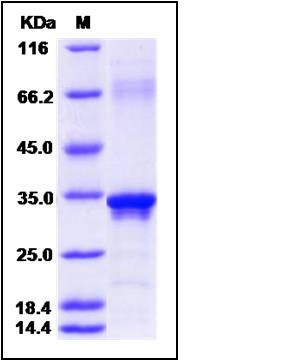Human Beta-amyloid 39 / Beta-APP39 Protein (aa 672-710, His & GST Tag)
AAA,ABETA,ABPP,AD1,APPI,CTFgamma,CVAP,PN-II,PN2
- 100ug (NPP3602) Please inquiry
| Catalog Number | P10703-H20E3 |
|---|---|
| Organism Species | Human |
| Host | E. coli |
| Synonyms | AAA,ABETA,ABPP,AD1,APPI,CTFgamma,CVAP,PN-II,PN2 |
| Molecular Weight | The recombinant human Beta-APP39/GST chimera consists of 278 amino acids and has a calculated molecular mass of 32.2 KDa. It migrates as an approximately 34 KDa band in SDS-PAGE under reducing conditions. |
| predicted N | Met |
| SDS-PAGE |  |
| Purity | > 85 % as determined by SDS-PAGE |
| Protein Construction | A DNA sequence encoding the amino acids (Asp672-Val710) of human Amyloid beta A4 protein (APP770) (P05067-1), corresponding to the Beta-amyloid protein 39, was fused with the N-terminal polyhistidine-tagged GST tag at the N-terminus. |
| Bio-activity | |
| Research Area | Cancer |Signal transduction |Other Signal Transduction Molecules |
| Formulation | Lyophilized from sterile 50 mM Tris, 100 mM NaCl, 20% glycerol, 0.05% Tween 20, pH 9.5. 1. Normally 5 % - 8 % trehalose and mannitol are added as protectants before lyophilization. Specific concentrations are included in the hardcopy of COA. |
| Background | Amyloid precursor protein (APP) is a type I transmembrane protein expressed in many tissues and concentrated in the synapses of neurons, and is suggested as a regulator of synapse formation and neural plasticity. APP can be processed by two different proteolytic pathways. In one pathway, APP is cleaved by β- and γ-secretase to produce the amyloid-β-protein (Aβ, Abeta, beta-amyloid) which is the principal component of the amyloid plaques, the major pathological hallmark of Alzheimer’s disease (AD), while in the other pathway, α-secretase is involved in the cleavage of APP whose product exerts antiamyloidogenic effect and prevention of the Aβ peptide formation. The aberrant accumulation of aggregated beta-amyloid peptides (Abeta) as plaques is a hallmark of AD neuropathology and reduction of Abeta has become a leading direction of emerging experimental therapies for the disease. Besides this pathological function of Abeta, recently published data reveal that Abeta also has an essential physiological role in lipid homeostasis. Cholesterol increases Abeta production, and conversely A beta production causes a decrease in cholesterol synthesis. Abeta may be part of a mechanism controlling synaptic activity, acting as a positive regulator presynaptically and a negative regulator postsynaptically. The pathological accumulation of oligomeric Abeta assemblies depresses excitatory transmission at the synaptic level, but also triggers aberrant patterns of neuronal circuit activity and epileptiform discharges at the network level. Abeta-induced dysfunction of inhibitory interneurons likely increases synchrony among excitatory principal cells and contributes to the destabilization of neuronal networks. There is evidence that beta-amyloid can impair blood vessel function. Vascular beta-amyloid deposition, also known as cerebral amyloid angiopathy, is associated with vascular dysfunction in animal and human studies. Alzheimer disease is associated with morphological changes in capillary networks, and soluble beta-amyloid produces abnormal vascular responses to physiological and pharmacological stimuli. |
| Reference |
